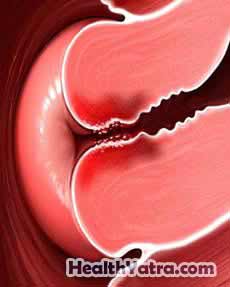Cervical Conization Surgery Definition
Cervical conization is done to remove a cone-shaped piece of tissue from the cervix. The cervix is located at the top of the vagina and is the entry way into the uterus (womb).
Reasons for Procedure
A cervical conization is used to diagnose and to treat cervical cancer or precancerous changes in the cervix. The procedure takes place after a woman has had abnormalPap smears. Pap smears are screening tests to detect abnormal, pre-cancerous, and cancerous cells in the cervix.

Possible Complications
Complications are rare, but no procedure is completely free of risk. If you are planning to have a cervical conization, your doctor will review a list of possible complications, which may include:
- Infection
- Bleeding
- Premature delivery with future pregnancies
- Scarring of the cervix
Factors that may increase the risk of complications include:
- Smoking
What to Expect
Prior to Procedure
Do not eat or drink anything for 8 hours prior to the procedure.
Anesthesia
You will be given some type of anesthesia. These options include:
- Local anesthetic—The area will be numbed. IV sedation may also be given to help you relax.
- Regional anesthesia (epidural, spinal)—The lower half of the body will be numb.
- General anesthesia —You will be asleep.
Description of the Procedure
A speculum will be inserted into the vagina, similar to a Pap smear. It will hold your vagina open and allow instruments to pass easier. Your doctor will use a knife, laser, or heated loop to remove a cone-shaped piece of tissue from the cervix. If there are abnormal cells, they will also be removed. Self-absorbable sutures may be placed in the cervix to control bleeding.
The tissue will be sent to a lab to test for cancer. The test results will be available within a week.
How Long Will It Take?
The procedure will take less than an hour.
How Much Will It Hurt?
Anesthesia will prevent pain during this procedure. After the procedure, you may have some discomfort. You can take pain relievers to help manage any discomfort.
Postoperative Care
At the Care Center
You will rest in a recovery area until the anesthesia wears off. When you are awake and aware, you will be able to go home.
At Home
When you return home, do the following to help ensure a smooth recovery:
- You may have some bleeding or discharge from your vagina for several days postsurgery. A sanitary napkin or pad may be worn. Tampons should not be used for a month or more after the surgery.
- Sexual intercourse is discouraged for 4-6 weeks.
- Showers and baths are OK.
- Be sure to follow your doctor’s instructions .
A postoperative exam takes place at six weeks.
Call Your Doctor
After arriving home, contact your doctor if any of the following occurs:
- Signs of infection, including fever, chills, or smelly discharge from vagina
- Heavy vaginal bleeding (This may not occur until about one week after the operation, when the healing scar is shed from the cervix.)
- Abdominal or pelvic pain that worsens
In case of an emergency, call for medical help right away.
